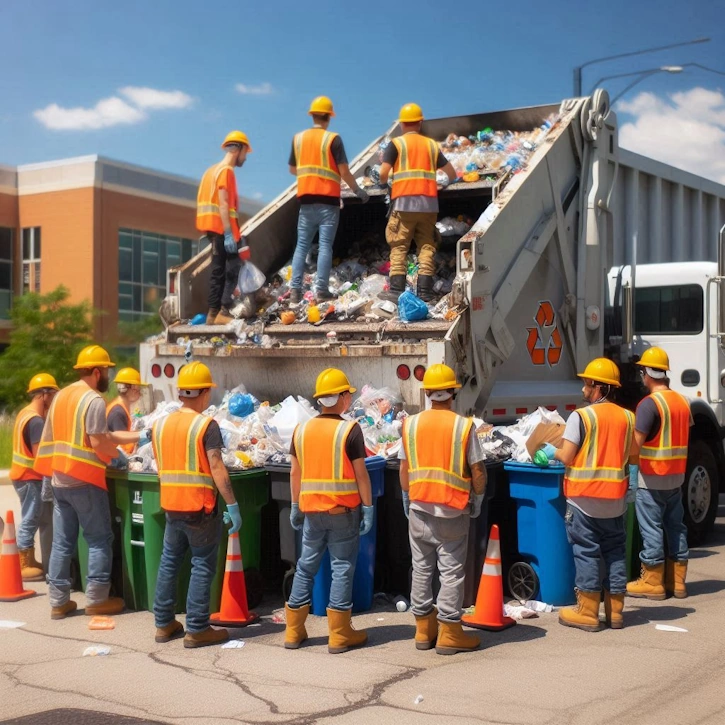
California, with its position as the leader in state action on the environment and its large, diverse economy boasts one of the most sophisticated waste management markets in all of North America.
California’s waste market is an evolving sector driven by tight state regulation, new technology and a sustainability oriented culture. The mix of industries and residents in the state presents a distinct blend of challenges and opportunities for waste collection, recycling, composting, and disposal services.
Market Overview and Trends of California Waste Management
Regulatory Framework
The waste management market is heavily influenced by California’s stringent environmental regulations. Assembly Bill (AB) 341 and AB 1826 both require commercial recycling and organic waste diversion, while SB 1383 is aimed at achieving a 75% reduction in organic waste disposal in landfills by the year of implementation to reduce the emission of methane. These policies encourage innovative business and municipal investments on waste management solutions.
Urbanization: Changing the dynamic of how we live
California, as the most populated state in the US produces millions of tons of municipal solid waste (MSW) per year. The trend of fast urbanization of cities like Los Angeles, San Francisco, Ontario and San Diego increases the amount of waste produced which creates a need for collection, recycling, and disposal services in an efficient manner.
Sustainability Goals
California has very ambitious waste reduction goals, a 75% recycling rate and significant reductions in landfill dependency. They encourage investment on recycling infrastructure, composting facilities and waste-to-energy technologies.
Key Waste Management Players in California
Dumpster Rental Companies
The biggest players globally for waste collection, recycling and disposal services are present in California. Some for example are deeply involved in the creation of San Francisco’s zero-waste program: a model for cities across the country.
Recycling Facilities
California has sophisticated recycling for paper, plastics, metals and electronic waste. It is also at the forefront of innovations in plastic recycling, with facilities currently experimenting with chemical recycling to convert non-recyclable plastics into source materials.
Composters and Organic Waste Processors
Agromin and Recology have large composting facilities that process organic waste into compost and soil amendments. These facilities are essential to fulfill SB 1383.
Landfills and Waste-to-Energy facilities
Though California does everything in its power to keep as much waste out of a landfill as possible, they are still a necessity for rubbish that cannot be recycled. Massachusetts also operates several waste-to-energy facilities that make energy and electricity from the trash while minimizing landfill volume and producing renewable energy.
Segmenting California Waste Management Market By Type
Municipal Solid Waste (MSW)
Municipal solid waste (MSW) constitutes a major portion of the waste stream in California. Local programs emphasize curbside recycling, composting, and public education to minimize contributions to landfills.
Water in Circular Economy (C&D)
Infrastructure projects and urban development, such as the construction of housing and transportation, generates a substantial amount of C&D waste in California. Some cities have writs which command the contractors to recycle or reuse C&D supplies that include concrete, wood and steel.
E-Waste
California, being a tech hub, generates a lot of electronic waste. Laws like the Electronic Waste Recycling Act regulate the disposal and recycling of computers, televisions, batteries and other devices.
Organic Waste
The emphasis is on organic waste such as food scraps and yard trimmings because landfills are a significant source of methane emissions. With its organics diversion mandate, SB 1383 leads to an increase of composting and anaerobic digestion facilities.
Hazardous Waste
Some California industries generate hazardous waste that needs tailored treatment and disposal. Hazardous materials are managed by companies such as Clean Harbors which handle them in a safe and environmentally sound manner.
Difficulties Faced by California in Its Waste Management Market
Recycling Market Instability
Changes in the world market, like China’s 2018 National Sword policy that rejected foreign trash and trash imports into China, upset recycling export tons worldwide, and California has begun to pay for it by investing more into its own domestic recycling infrastructure.
High Operating Costs
Compliance with California’s stringent regulations, in addition to high labor and infrastructure expenses, can create a financial burden for waste management companies.
Impurities in Recycling Streams
As a consequence, recycler-processing heavy metals or certain types of plastic will struggle to get rid of contaminants making it expensive and inefficient.
Infrastructure Gaps
Urban centers like Ontario have well-developed solid waste management systems, but rural areas miss out on more sophisticated facilities such as those for composting and recycling.
Innovations and Opportunities
Waste-to-Energy Technologies
It is considering advanced waste-to-energy technologies like pyrolysis and gasification to produce low-emissions energy from waste.
Circular Economy Initiatives
More companies and municipalities are applying circular economy principles to eliminate waste in the first place and design for maximum resource recovery.
Organic Waste Diversion
As development of composting and anaerobic digestion facilities increase, there are chances to divert organic waste from landfills into valuable commodities such as finished compost and biogas.
Waste Management Firms with Cutting-edge Technology
IoT-enabled waste bins, route optimization software, and sorting using artificial intelligence make it more efficient and cost-effective.
Future Outlook
As California’s sustainability and innovation policies ramped up to meet the challenges of interconnected crises as we entered this new decade, California’s waste management market is primed for growth.
These changes will also require investments to scale recycling infrastructure, composting facilities and waste-to-energy technologies delivering the state’s ambitious goals. California has set an example for waste management that could be beneficial for the rest of the country by encouraging public-private partnerships and innovation.
References
- https://www.ontarioca.gov/sites/default/files/Ontario-Files/Municipal-Utilities-Company/ab341_and_ab1826_0.pdf
- https://calrecycle.ca.gov/
- https://www.dumpsterrentalnearmeontarioca.com/
- https://www.twcvv.org/how-the-pandemic-has-affected-garbage-collection-in-the-usa/
- https://www.twcvv.org/us-landfill-management/
- https://www.twcvv.org/san-diego-waste-management-law/